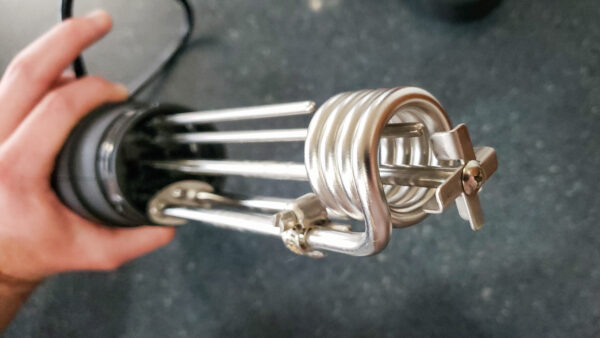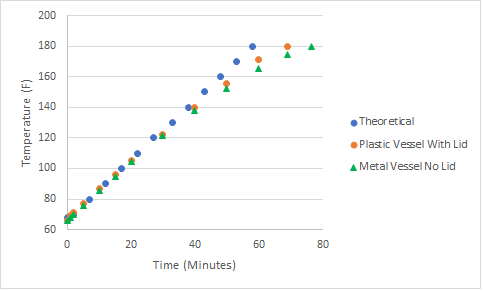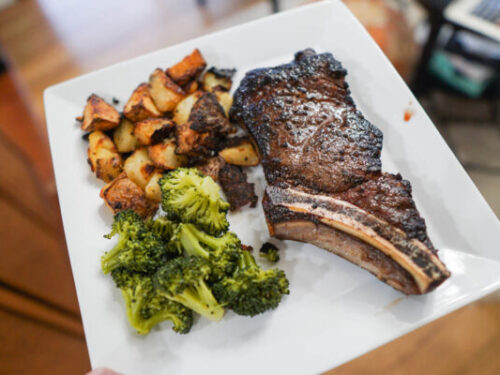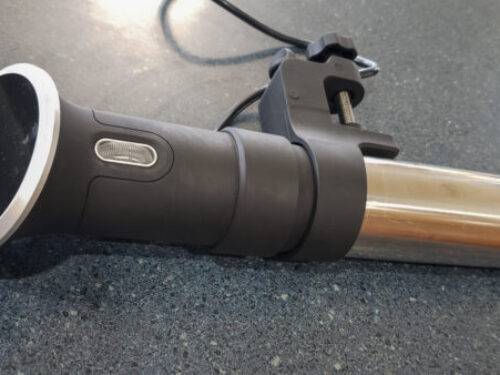Disclaimers: Our site uses demographic data, email opt-ins, display advertising, and affiliate links. Please check out our Terms and Conditions for more information.
When you start shopping for a sous vide, you may quickly notice that companies have many different models out there.
While these models have an array of features you may want to consider, one element you will likely notice right away is the wattage rating. Much like a microwave, the wattage rating of your sous vide will be directly proportional to how fast it heats up your water bath.
But which wattage is best for you? Well, we dive deep into how the difference in wattage will impact the heating of your water bath in this one!
Sous Vide Wattage is a Simple Calculation
To figure out rough estimates on how long it would take to heat up a vessel of water, we can do the math as the calculation is pretty straightforward. The energy required to heat water is well known and is simply the following:
Time (sec) = M * ΔT * 4,168 / W
- Time (in seconds) to heat the water
- M is the mass of water, in kilograms
- ΔT is the difference between the start and end temperatures, in Celsius
- 4,168 is the conversion factor to joules/kg/°C
- W is the wattage input of the device (also described as joules/second)
This calculation is based on a perfect transfer of heat such that all energy is going directly into the water. As our containers are not perfect insulators, and no device is 100% efficient, this calculation offers a glimpse at the best-case theoretical limit. In practice, heating the water bath will be slower.
So, let's look at some numbers, shall we? (Calculate your own scenarios via this website.)
Let's say you were heating up a 12 L vessel from room temperature (68 °F) to 140 °F. The amount of time it would take by wattage would be the following:
- 800 watt: 42 minutes
- 900 watt: 38 minutes
- 1000 watt: 34 minutes
- 1200 watt: 28 minutes
As you can see, a 50% increase in wattage would likely heat the same amount of water about 33% faster in a perfect world. Thankfully, we can speed things up a bit by adding already hot water into our sous vide vessel. Your mileage may vary, but generally speaking, hot water comes out from our tap at around 120 °F. Now we shrank the delta from 72 °F to just 20 °F. How does that influence the time? The same 12 L vessel from 120 °F to 140 °F would be the following:
- 800 watt: 12 minutes
- 900 watt: 11 minutes
- 1000 watt: 10 minutes
- 1200 watt: 8 minutes
As you can see, raising the temperature of already warm water just a small amount is an inconsequential time difference, whereas heating up from room temperature offers a much bigger disparity between the wattage output.
What if you were heating a much larger volume of water, say, 24 L instead of 12 L? From room temperature (68 °F) to 140 °F we get the following:
- 800 watt: 84 minutes
- 900 watt: 75 minutes
- 1000 watt: 67 minutes
- 1200 watt: 56 minutes
But if you're raising already warm water (120 °F) to 140 °F, it looks like the following:
- 800 watt: 24 minutes
- 900 watt: 21 minutes
- 1000 watt: 19 minutes
- 1200 watt: 16 minutes
Once again, the disparity is much, much smaller when you're only adding a little bit of energy into the system even over a larger volume of water. In fact, we had all the equipment at home to set up a test of our own, so we thought we'd see what the real-life difference is for our own sous vide (900W rating) and 12 L water bath vessel*.
Sous Vide Heating Performance vs Theoretical
To really see how our sous vide actually performed, we heated up room temperature water to a target of 180 °F in both a plastic vessel with lid as well as in a metal stockpot without a lid. We then plotted the generated graphs against the theoretical data as discussed above. The results looked like this:
Let's talk about each case individually, shall we?
Plastic Container With Lid
To go from 66 °F to 140 °F in a plastic container with lid, our 900W sous vide took about 40 minutes whereas to go from 120 °F to 140 °F it only took 11 minutes. As our theoretical calculations would've estimated this would take 37 minutes and 10 minutes respectively (roughly 2 °F per minute), you can see that overall efficiency is quite good- this setup was off about 8-10%.
In fact, the sous vide was quite close to theoretical cases up until about 110 °F. From there, we noted a slight lag behind theoretical temperatures which became a bit more significant at higher temperatures. Our 180 °F final setpoint took about 19% longer than what theoretical calculations would indicate (about 11 minutes difference), but we do also have to admit that we rarely cook at these temperatures anyway.
Overall, we'd say this is not bad at all. 11 minutes to take hot water from our tap to ready to cook most dishes is quite fast in our opinion and the lag at higher temperatures is not a deal-breaker in the slightest. Hooray plastic vessels with lids!
Metal Container Without a Lid
To go from 66 °F to 140 °F in a metal container without a lid, our 900W sous vide took about 41.5 minutes whereas to go from 120 °F to 140 °F it only took 11.5. Much like with the plastic container, the overall efficiency was still quite good- this setup was off just about 9%-11.5%. The difference is almost inconsequential over this temperature range.
The performance of the metal container fell in line with our plastic container quite well up to this point, but the disparity started to grow at higher temperatures.
Whereas our plastic vessel took 19% longer to heat to 180 °F vs theoretical, the metal vessel without a lid took 32% longer vs theoretical. Still, it is worth keeping in mind we're talking about just 11 and 18.5 minutes respectively, so none of this is really a dealbreaker one way or another to us.
If we were to summarize this test, we saw two things.
First, sous vide is quite efficient in a plastic vessel with a lid and even still fairly efficient in a metal vessel without a lid. I'm actually surprised just how close it matched up to theoretical calculations at lower temperatures in both cases. I'd almost go as far as saying you don't necessarily need a plastic vessel unless you simply want one for convenience (especially if cooking at lower temperatures as we do). That being said, we like ours because we can see our food through the clear walls.
Second, if you're trying to decide what wattage is best for you, the figures we listed at the start of this article are going to be good guides as a starting point- real-world performance should match up close enough for most users.
- *Notes on this test: Our max volume in both our sous vide vessel and metal stock pot is 12 L. The sous vide occupied some of this space, so we recognize we were probably heating closer to 11-11.5 L of water (this could've varied a bit between the two vessels as well). Likewise, as your food will displace water as well, odds are good you would never fill a vessel like ours to 12L- meaning you'll likely reach target temperature even faster than in the above test. All good things!
So What Sous Vide Wattage Should You Get?
Really, in our opinion, there are only three instances where buying a higher wattage model sous vide makes sense based on this rating alone.
The first is if you will be routinely cooking recipes that require hotter temperatures (which for us is unlikely- we tend to operate around 125-140 °F for most dishes).
The second is if you are using the sous vide in large water bath vessels (the higher wattages also tend to circulate more water overall).
The final one is if your specific scenario means those extra couple of minutes are crucial to whatever it is you are doing.
Apart from hotter cooks, which is specific to your interests, the other two cases scream one scenario to me- professional chefs. Here, time is likely of the essence and you may also be using a large water bath to heat up many meals at once (and even have multiple sous vide). In which case, the higher-rated sous vide (by wattages) could be worth the extra cost.
Now, of course, wattage alone isn't the only difference you may find between models. Companies typically add extra features into the higher-end models as well beyond wattage improvement. We'd be remiss to not talk about those as well since they can go hand-in-hand.
A quick glance at the higher-end models of Anova sous vide shows features including adjustable clamps, higher circulation rates (great for bigger vessels as noted above), and even max lifetime of the device outright. As such, if any of these are of interest to you, we may think you would use that as a deciding factor over wattage itself. Personally, we paid for a 900W model (now replaced by a 1000W model) purely for the adjustable clamps, and everything else is just a bonus- the adjustable clamp is more than worth the price.
As home sous vide users we're already doing long cooks to begin with, an extra minute or two to heat the water isn't really a deal-breaker one way or another. As such, we looked to other aspects of the device to guide making our final purchase.
Read More About Sous Vide
Want to learn more about sous vide cooking? Check out some of our top posts:





